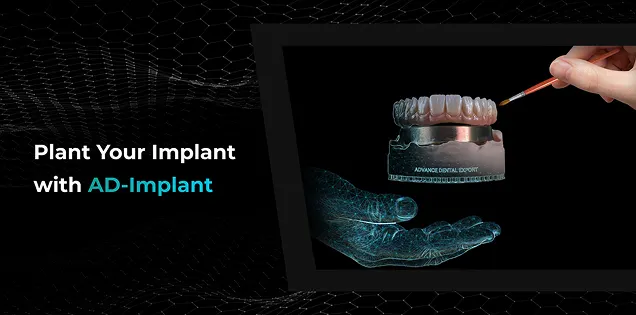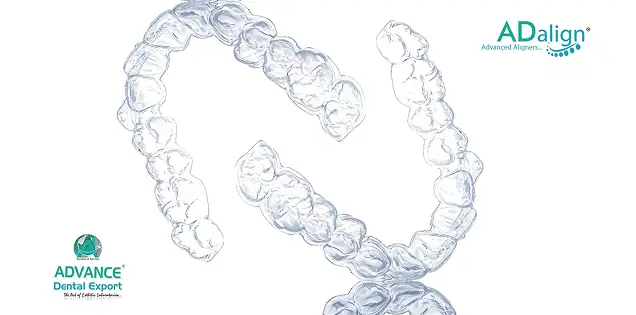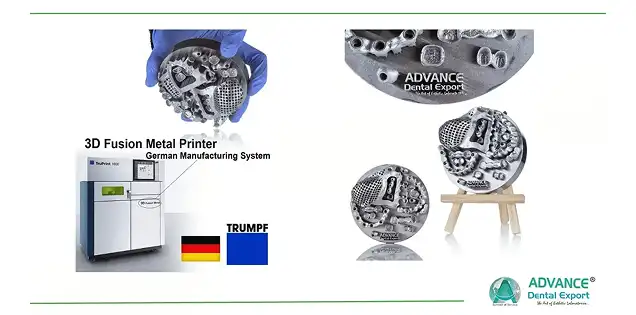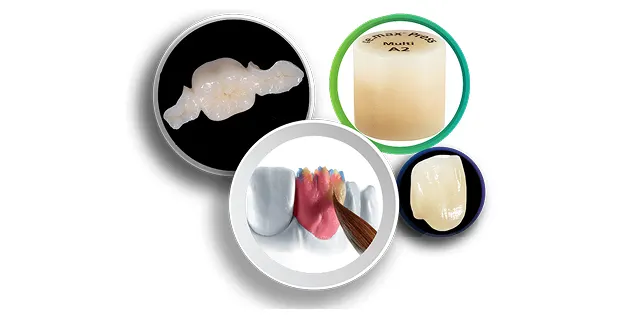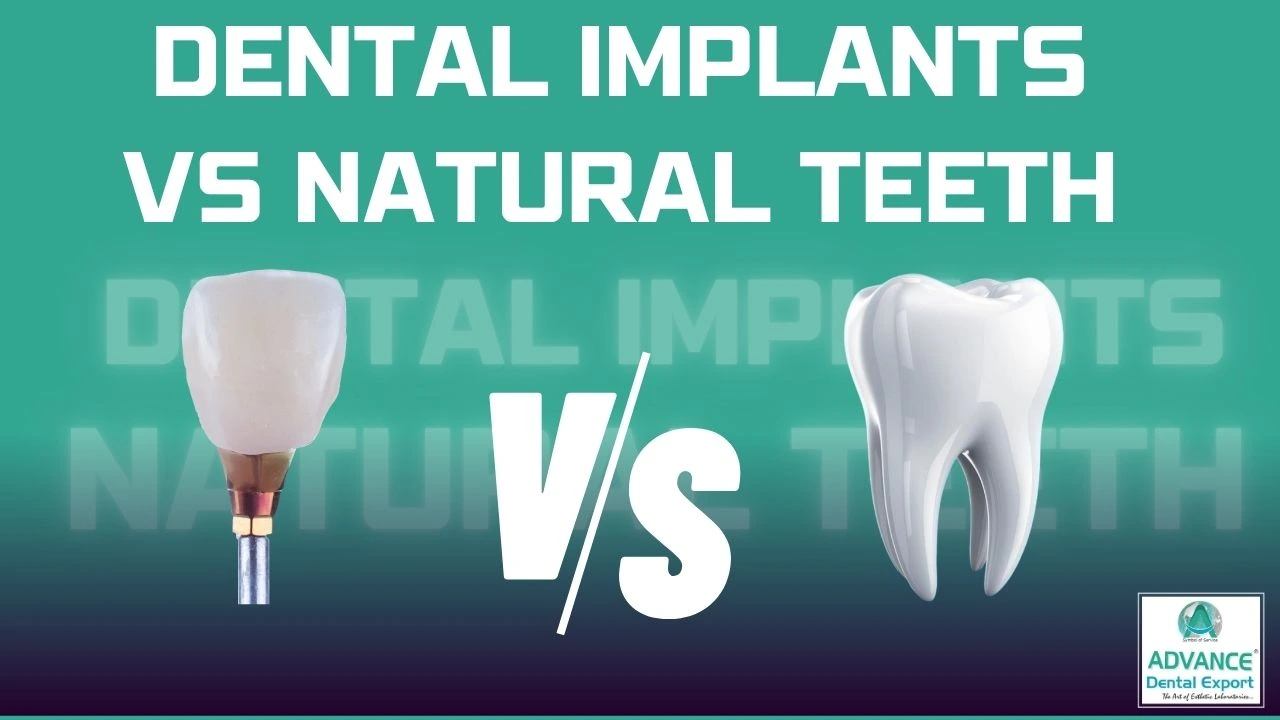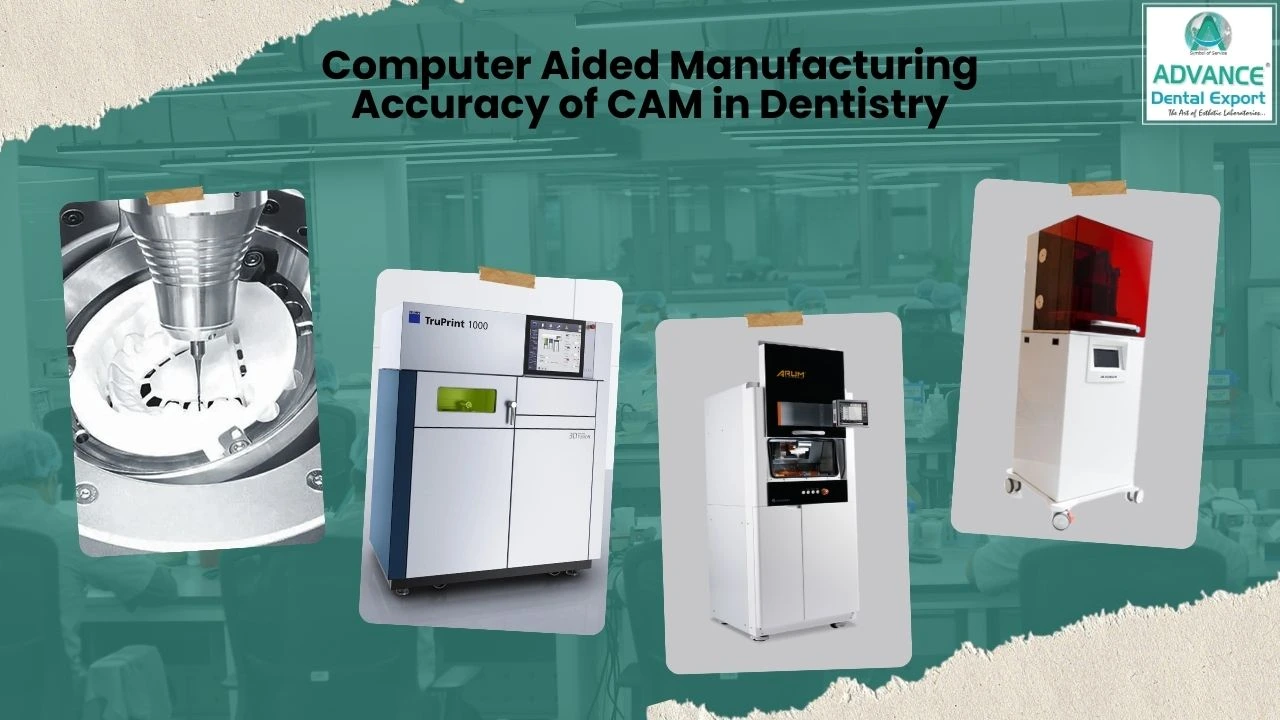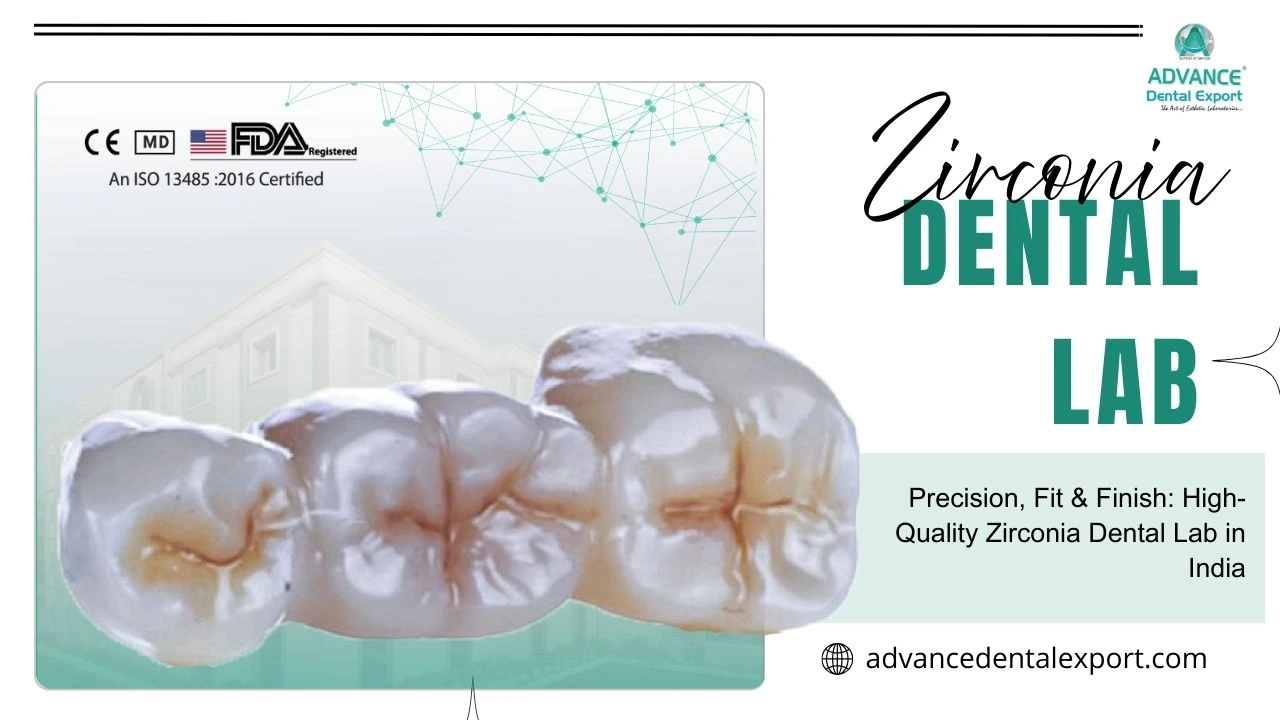The type of zirconia crown you choose can directly influence the success of the restoration. Aesthetics, occlusal load, preparation design, and cementation requirements all play a huge role.
But with so many options available, it’s easy to feel confused about what’s best for your patient. This guide breaks down the three main types of zirconia crowns: monolithic, layered, and multilayered; and also explains how yttria content (3Y, 4Y, 5Y) affects strength and translucency.
Read on for practical insights into their indications, limitations, and bonding protocols to help you choose the right type of zirconia crown.
Types of Zirconia Crowns
Zirconia crowns are solid ceramic tooth caps made from zirconium dioxide, a material known for its strength and fracture resistance.
Based on manufacturing technique, there are three main types of zirconia crowns:
- Monolithic Zirconia: strong, single-block restorations
- Layered Zirconia: zirconia core layered with porcelain
- Multilayered Zirconia: a single block with internal layers of varying translucency and strength
They can also be classified by yttria content (3Y, 4Y, 5Y), which affects the material’s optical properties and flexural strength.
A combination of yttria-stabilised zirconia and the layering technique helps achieve the desired balance between strength and translucency.
Let’s break all zirconia crown types down one by one.
Monolithic Zirconia Crown
Monolithic zirconia crowns are milled from a single solid block of zirconium dioxide using CAD/CAM. Known for being nearly unbreakable, they are ideal for high-stress zones like posterior teeth.
Monolithic Zirconia Features:
- Made from 3Y zirconia: high-strength, low translucency
- Flexural strength : ~900 –1200 MPa
- Low translucency: less aesthetic for anterior use
- High fracture toughness, resistant to chipping or cracking
- Excellent wear resistance and stain-proof
Tooth Preparation Guidelines
- Allows for minimal reduction: 0.8 –1 mm
- Suitable for short or tapered preps with limited occlusal clearance
- Chamfer or shoulder margins recommended
Indications:
- Posterior crowns and bridges
- Full-arch or full-mouth reconstructions
- Patients with bruxism or heavy occlusal loads
Limitations:
- More opaque: not indicated in the aesthetic zone
- May abrade opposing enamel if not well-polished
Layered Zirconia Crown
Layered zirconia crowns consist of a zirconia core with hand-layered feldspathic or lithium disilicate porcelain. This technique improves aesthetics, but introduces layering-related risks.
Features:
- Zirconia core + layered porcelain veneer
- Flexural strength depends on core material (usually 3Y or 4Y zirconia)
- High translucency due to porcelain veneer
- Excellent aesthetics, closely mimics enamel
- Prone to chipping or delamination at the veneer interface
Tooth Preparation Guidelines:
- Requires more tooth preparation: 1.2–1.5 mm
- Shoulder or deep chamfer margins preferred for porcelain support
- Adequate clearance is needed to accommodate the veneering layer
Indications:
- Anterior crowns where superior aesthetics is critical
- Single-unit restorations in low-stress areas
- Patients with high cosmetic expectations
Limitations:
- Less suitable for bruxers or heavy occlusal loads
- Higher risk of chipping compared to monolithic
- More technique-sensitive fabrication
Multilayered Zirconia Crown
Multilayered zirconia is fabricated from gradient-shaded blocks that vary in strength and translucency based on the yttria content . No layering is done manually; the natural shade transition is built into the material.
Explore Our Restorations
Features:
- Gradient material: cervical is stronger, incisal more translucent
- Made from 4Y or 5Y zirconia for improved translucency
- Combines the aesthetics of layered and the strength of monolithic
- Flexural strength ranges ~700–1000 MPa (depending on yttria content)
Tooth Preparation Guidelines:
- Moderate reduction: 1.0–1.2 mm
- Chamfer or shoulder margins recommended
- Ensure sufficient incisal reduction to capture translucent zones
Indications:
- Anterior and posterior crowns
- Single-unit restorations require a blend of strength and aesthetics
- Cosmetic zone cases where layered zirconia is not ideal
Limitations:
- Less strong than monolithic (esp. 5Y variants)
- May not be suitable for long-span bridges or bruxers
- Still slightly opaque compared to glass ceramics
Cementation & Adhesion Protocols for Zirconia Crowns
Monolithic Zirconia Crowns:
Combined mechanical + chemical approach offers optimal bond strength. Air abrasion improves micromechanical retention while the 10-MDP chemically bonds with zirconia, forming stable phosphate-zirconia bonds (P–O–Zr).
- Etching not required; zirconia is acid-resistant
- Air abrasion with 30–50 μm alumina at 0.5–2.5 bar pressure.
- Routine cases: RMGI cement works well
- Short or tapered preps: use MDP-based resin cement
- Use zirconia primers with 10-MDP for better bond strength
- Avoid conventional total-etch resin cement protocols
Layered Zirconia Crowns
Zirconia core responds best to abrasion and MDP-based bonding, while the porcelain layer follows conventional glass ceramic bonding via HF etching + silanization.
Core (Zirconia) Side:
- Follow the monolithic zirconia protocol
- Abrasion + MDP primer + resin cement
Veneer (Porcelain) Side:
- Etch with hydrofluoric acid (usually 5–9%) for 60–90 seconds.
- Rinse, dry, and apply silane coupling agent.
- Use resin cement: dual/self-cure as required.
Multilayered Zirconia Crowns
Despite esthetic and structural gradients, the surface behaviour of multilayered zirconia crowns is similar to conventional monolithic zirconia.
- Air-particle abrasion (30–50 μm alumina, 0.5–2.5 bar).
- Apply MDP-containing primer.
- Cement with 10-MDP–based dual/self-cure or self-adhesive resin cement.
Here’s an overview of the evidence-based adhesion protocols for monolithic vs layered vs multilayered zirconia crowns:
| Zirconia Type | Mechanical Conditioning | Chemical Promoter | Cement Type |
| Monolithic | Air abrasion (Al₂O₃, 30–50μm) | MDP-primer | Resin (dual/self-adhesive) |
| Layered (Core) | Air abrasion (core surface) | MDP-primer (core) | Resin (dual/self-adhesive) |
| Layered (Veneer) | HF etching (veneer side) | Silane coupling agent | Resin |
| Multilayered | Air abrasion | MDP-primer | Resin (dual/self-adhesive) |
With a thorough understanding of these bonding strategies, let us understand the role of yttria content in choosing the type of zirconia crown.
3Y and 5Y Zirconia
Zirconia crowns are classified as 3Y, 4Y, or 5Y based on the amount of yttrium oxide (Y₂O₃) used to stabilise them. This yttria content directly influences the strength vs translucency dynamic, which are the two most important factors in crown selection.
3Y Zirconia
The 3Y zirconia has 3 mol% Yttria-stabilised Tetragonal Zirconia Polycrystal and is also called 3Y-TZP.
Features:
- High strength (~1200 MPa)
- Opaque appearance
- Ideal for monolithic zirconia crowns
- Best suited for high-stress zones like posterior teeth and bruxism patients
5Y Zirconia
The 5Y zirconia has 5 mol% Yttria-stabilised Partially Stabilised Zirconia – 5Y-PSZ and is also called high translucent zirconia.
Features:
- Lower strength (~600–800 MPa) but significantly higher translucency
- Mimics natural enamel
- Ideal for cosmetic restorations in the anterior region
- Less suitable for long-span bridges or heavy bite force cases
A third type, 4Y zirconia, serves as a middle ground between 3Y and 5Y zirconia. It contains a higher proportion of yttrium oxide (approximately 4 mol%), which increases the cubic phase content at the expense of the tetragonal phase, resulting in improved translucency compared to 3Y.
The 4Y zirconia has lower flexural strength, around 550–800 MPa, but remains suitable for anterior cases and restorations in the aesthetic zone.
Here’s an overview of the different types of zirconia for crowns:
[TABLE BELOW]
| Type | Composition (Yttria Content) | Aesthetics | Best Used For |
| Monolithic Zirconia | Mostly 3Y-TZP | Low to moderate translucency | Posterior teeth, bruxism cases |
| Layered Zirconia | 3Y or 4Y core & porcelain layer | High: mimics natural enamel | Anterior teeth, cosmetic restorations |
| Multilayered Zirconia | Gradual 3Y–5Y blend | Moderate to high translucency | Both anterior and posterior restorations |
| High Translucency Zirconia | 5Y-PSZ (Partially Stabilised Zirconia) | Very high like enamel | Cosmetic zones, short-span bridges |
Looking for a trusted lab partner? Get high-precision restorations from Advance Dental Export
Take-Home Message
Zirconia crowns are a durable and versatile solution for high-stress posterior restorations and esthetically demanding anterior cases.
- Monolithic zirconia is best suited for posterior teeth and patients with parafunctional habits due to its high strength and minimal chipping risk.
- Layered zirconia is ideal for esthetic cases in the anterior region, but requires precise handling, adequate occlusal clearance, and should be avoided in bruxers.
- Multilayered zirconia combines gradient translucency with high strength, making it suitable for esthetic zones, including premolars, where both appearance and durability are important.
Choosing the right type of zirconia crown based on occlusal load, aesthetic demands, and material properties helps ensure long-term clinical success. So, choose wisely, choose Advance Zirconia .
FAQs
When to choose monolithic zirconia for dental crowns?
Monolithic zirconia crowns are the strongest and have low translucency. They are preferred for posterior teeth, for patients with a habit of grinding their teeth (bruxism), and in areas where there is a lot of pressure. They are also used for CAD/CAM crowns.
Layered zirconia crowns: how to find the best balance of beauty and durability?
In a layered zirconia crown, an aesthetic layer of porcelain is fused to a strong zirconia core. This combines the strength of zirconia with the natural appearance (color and translucency) of porcelain. It is particularly preferred for anterior teeth where functional stress is low and aesthetics are important. However, porcelain is at risk of chipping.
What is a multilayered zirconia crown, and why is it best for a natural smile?
Multilayered zirconia crowns are made from a single zirconia block, with different layers of color and translucency, similar to natural teeth. This gives them a very realistic and lifelike appearance. They are best for aesthetic zones (e.g., premolars) and short-term bridges because they reduce the risk of porcelain chipping and offer an excellent balance of strength and beauty.
Zirconia crown strength vs translucency: what’s the difference between 3Y-TZP, 4Y, and 5Y?
There are different types of zirconia that differ in their ratio of strength to translucency:
3Y-TZP: This is the strongest type, but has the lowest translucency. It is used in monolithic crowns and CAD/CAM applications.
4Y: This has a balanced ratio of strength and translucency. It is suitable for layered zirconia, especially for premolars and some anterior cases.
5Y: This has the highest translucency, but has the lowest strength. It is ideal for low-pressure anterior restorations where aesthetics are paramount.
How to choose the best zirconia dental crown for your dental needs?
Choosing the best zirconia dental crown requires considering your dental condition, aesthetic expectations, chewing power (functional load), and budget. Your dentist will evaluate your mouth and recommend which crown is best for you, whether monolithic, layered, or multilayered zirconia, based on your needs.

